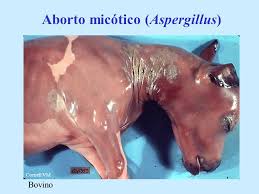Fungal agents are opportunistic microorganisms that are installed in the uterus of mares almost always by gynecological maneuvers performed without the corresponding asepsis. The use of antibiotic drugs in prolonged treatment is also usually a predisposing factor . In general, fungi cause placentitis and consequent fetal death in the last third of management. Although fungal abortions have a low incidence rate, they should be mentioned and taken into account.

Aspergillus fumigatus
It is the most frequently found fungus. To a lesser extent, the event occurs with the agents of the Mucorales order. It is assumed that A. fumigatus reaches the placenta by blood circulation from parietal lesions of the lungs or intestine. Oral and aerogenous routes can also be a gateway, after ingestion or inhalation of spores from moldy hay or straw when mares are pregnant. Although fungal agents may be incorporated into the uterus during service , it is highly unlikely that it will infect the placenta since it has a remarkable defense mechanism.
Equine abortions due to A. fumigatus usually occur between 8-11 months of pregnancy. The infection severely alters the chorioallantois causing necrosis and thickening that interferes with the nutrition of the fetus, causing emaciation and death . Although it is not frequent, the fetus can become infected through the bloodstream through the umbilical vessels, or through the amnion or allantois. Sometimes the fetus can be born alive, but it dies shortly after.
Symptoms
A few days before the abortion , the mares show swollen, milk- filled breasts . There may be brownish- colored vulvar discharges . After the mare has aborted, there is usually a purulent discharge from the vulva that returns after a few days of evolution.
Diagnosis
Aspergillus fumigatus can be cultured from the placenta, lungs , liver, and stomach of the fetus.
Necropsy of the fetus
The size of the fetus is usually too small for the time of gestation. The main alteration is in the placenta, notably thickened and with areas of necrosis that take on a grayish- yellow color . In the amnion there are necrotic plaques that may be attached to the skin of the fetus. Small whitish gray nodules appear in the lungs , the seat of Aspergillus fumigatus. The liver , in general, does not present alterations.
Prophylaxis
Gynecological maneuvers must be carried out under strict hygiene , since fungal agents could be incorporated into the mares’ reproductive tract before service. The animals do not have to be served until it is established, either through smears or cultures neck , which are free from infection .
